Reflection and Professional Development in Health and Social Care
VerifiedAdded on 2021/02/20
|9
|2734
|321
Report
AI Summary
This report delves into the concept of reflective practice within the context of health and social care. It begins by defining health and social care and then explores the purpose of reflection, emphasizing its role in enhancing experiences and fostering new working methods. The report examines various reflection models, such as the Gibbs Reflection Cycle, and discusses the application of practice themes like disciplined working, communication strategies, and team working to underpin learning and professional development. It also establishes the link between practice themes and performance indicators, highlighting methods for gaining evidence of effective reflective practice through reflective journals and peer groups. Furthermore, the report includes a portfolio of evidence using practice themes as a framework and details the improvements in personal and professional development achieved through reflection. Finally, it addresses the production of targets for career development, providing a comprehensive overview of the reflective process in health and social care.
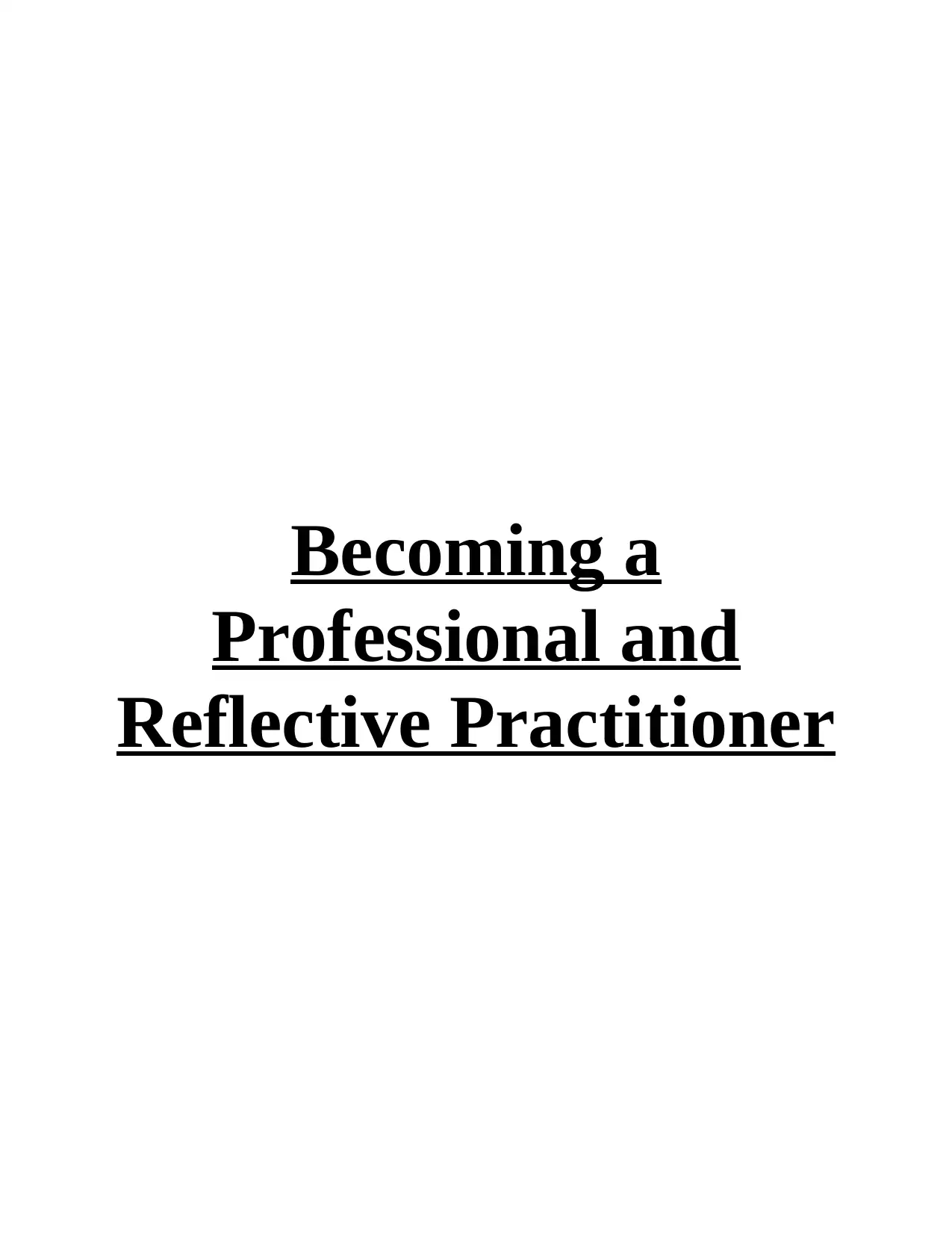
Becoming a
Professional and
Reflective Practitioner
Professional and
Reflective Practitioner
Paraphrase This Document
Need a fresh take? Get an instant paraphrase of this document with our AI Paraphraser
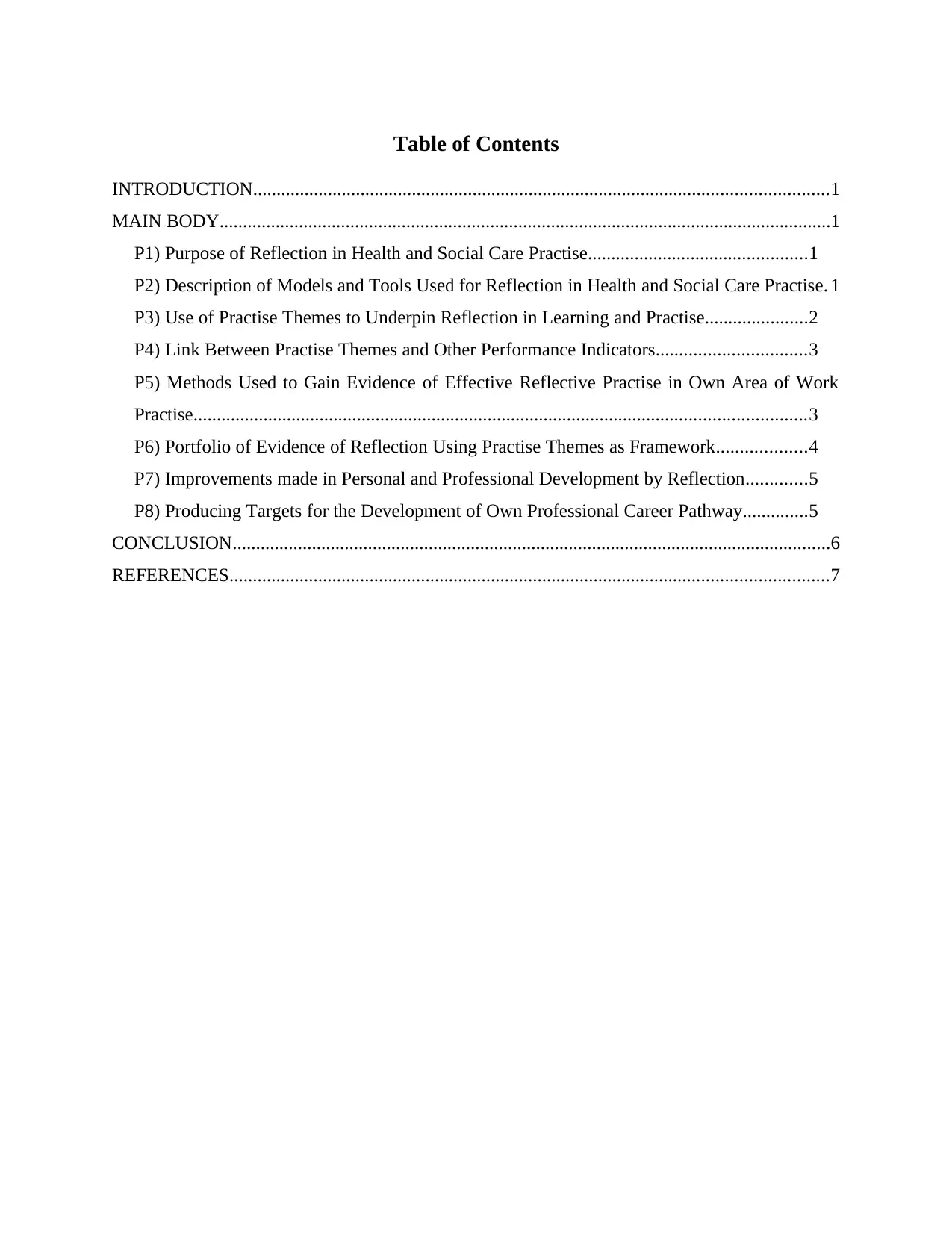
Table of Contents
INTRODUCTION...........................................................................................................................1
MAIN BODY...................................................................................................................................1
P1) Purpose of Reflection in Health and Social Care Practise...............................................1
P2) Description of Models and Tools Used for Reflection in Health and Social Care Practise. 1
P3) Use of Practise Themes to Underpin Reflection in Learning and Practise......................2
P4) Link Between Practise Themes and Other Performance Indicators................................3
P5) Methods Used to Gain Evidence of Effective Reflective Practise in Own Area of Work
Practise...................................................................................................................................3
P6) Portfolio of Evidence of Reflection Using Practise Themes as Framework...................4
P7) Improvements made in Personal and Professional Development by Reflection.............5
P8) Producing Targets for the Development of Own Professional Career Pathway..............5
CONCLUSION................................................................................................................................6
REFERENCES................................................................................................................................7
INTRODUCTION...........................................................................................................................1
MAIN BODY...................................................................................................................................1
P1) Purpose of Reflection in Health and Social Care Practise...............................................1
P2) Description of Models and Tools Used for Reflection in Health and Social Care Practise. 1
P3) Use of Practise Themes to Underpin Reflection in Learning and Practise......................2
P4) Link Between Practise Themes and Other Performance Indicators................................3
P5) Methods Used to Gain Evidence of Effective Reflective Practise in Own Area of Work
Practise...................................................................................................................................3
P6) Portfolio of Evidence of Reflection Using Practise Themes as Framework...................4
P7) Improvements made in Personal and Professional Development by Reflection.............5
P8) Producing Targets for the Development of Own Professional Career Pathway..............5
CONCLUSION................................................................................................................................6
REFERENCES................................................................................................................................7
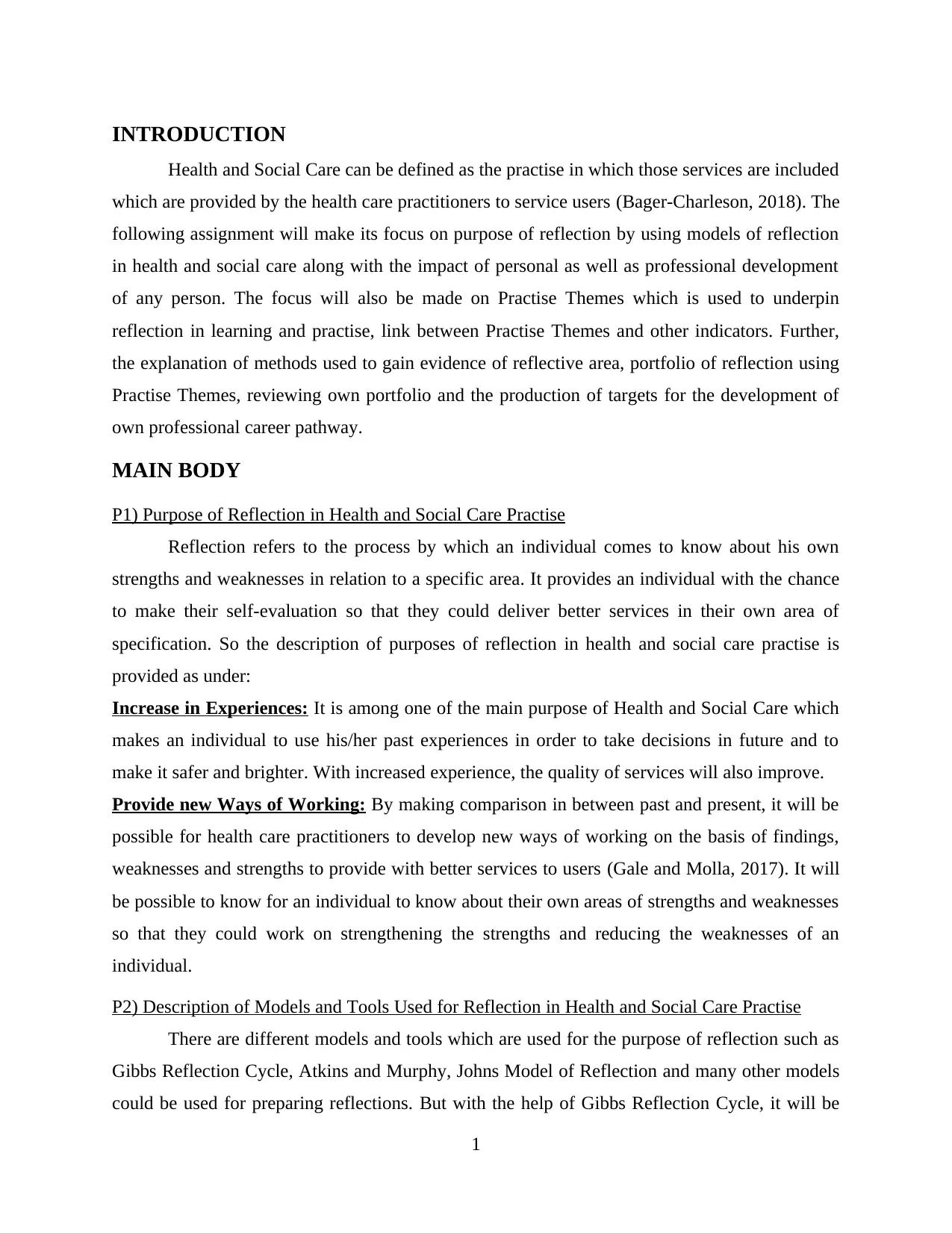
INTRODUCTION
Health and Social Care can be defined as the practise in which those services are included
which are provided by the health care practitioners to service users (Bager-Charleson, 2018). The
following assignment will make its focus on purpose of reflection by using models of reflection
in health and social care along with the impact of personal as well as professional development
of any person. The focus will also be made on Practise Themes which is used to underpin
reflection in learning and practise, link between Practise Themes and other indicators. Further,
the explanation of methods used to gain evidence of reflective area, portfolio of reflection using
Practise Themes, reviewing own portfolio and the production of targets for the development of
own professional career pathway.
MAIN BODY
P1) Purpose of Reflection in Health and Social Care Practise
Reflection refers to the process by which an individual comes to know about his own
strengths and weaknesses in relation to a specific area. It provides an individual with the chance
to make their self-evaluation so that they could deliver better services in their own area of
specification. So the description of purposes of reflection in health and social care practise is
provided as under:
Increase in Experiences: It is among one of the main purpose of Health and Social Care which
makes an individual to use his/her past experiences in order to take decisions in future and to
make it safer and brighter. With increased experience, the quality of services will also improve.
Provide new Ways of Working: By making comparison in between past and present, it will be
possible for health care practitioners to develop new ways of working on the basis of findings,
weaknesses and strengths to provide with better services to users (Gale and Molla, 2017). It will
be possible to know for an individual to know about their own areas of strengths and weaknesses
so that they could work on strengthening the strengths and reducing the weaknesses of an
individual.
P2) Description of Models and Tools Used for Reflection in Health and Social Care Practise
There are different models and tools which are used for the purpose of reflection such as
Gibbs Reflection Cycle, Atkins and Murphy, Johns Model of Reflection and many other models
could be used for preparing reflections. But with the help of Gibbs Reflection Cycle, it will be
1
Health and Social Care can be defined as the practise in which those services are included
which are provided by the health care practitioners to service users (Bager-Charleson, 2018). The
following assignment will make its focus on purpose of reflection by using models of reflection
in health and social care along with the impact of personal as well as professional development
of any person. The focus will also be made on Practise Themes which is used to underpin
reflection in learning and practise, link between Practise Themes and other indicators. Further,
the explanation of methods used to gain evidence of reflective area, portfolio of reflection using
Practise Themes, reviewing own portfolio and the production of targets for the development of
own professional career pathway.
MAIN BODY
P1) Purpose of Reflection in Health and Social Care Practise
Reflection refers to the process by which an individual comes to know about his own
strengths and weaknesses in relation to a specific area. It provides an individual with the chance
to make their self-evaluation so that they could deliver better services in their own area of
specification. So the description of purposes of reflection in health and social care practise is
provided as under:
Increase in Experiences: It is among one of the main purpose of Health and Social Care which
makes an individual to use his/her past experiences in order to take decisions in future and to
make it safer and brighter. With increased experience, the quality of services will also improve.
Provide new Ways of Working: By making comparison in between past and present, it will be
possible for health care practitioners to develop new ways of working on the basis of findings,
weaknesses and strengths to provide with better services to users (Gale and Molla, 2017). It will
be possible to know for an individual to know about their own areas of strengths and weaknesses
so that they could work on strengthening the strengths and reducing the weaknesses of an
individual.
P2) Description of Models and Tools Used for Reflection in Health and Social Care Practise
There are different models and tools which are used for the purpose of reflection such as
Gibbs Reflection Cycle, Atkins and Murphy, Johns Model of Reflection and many other models
could be used for preparing reflections. But with the help of Gibbs Reflection Cycle, it will be
1
⊘ This is a preview!⊘
Do you want full access?
Subscribe today to unlock all pages.

Trusted by 1+ million students worldwide
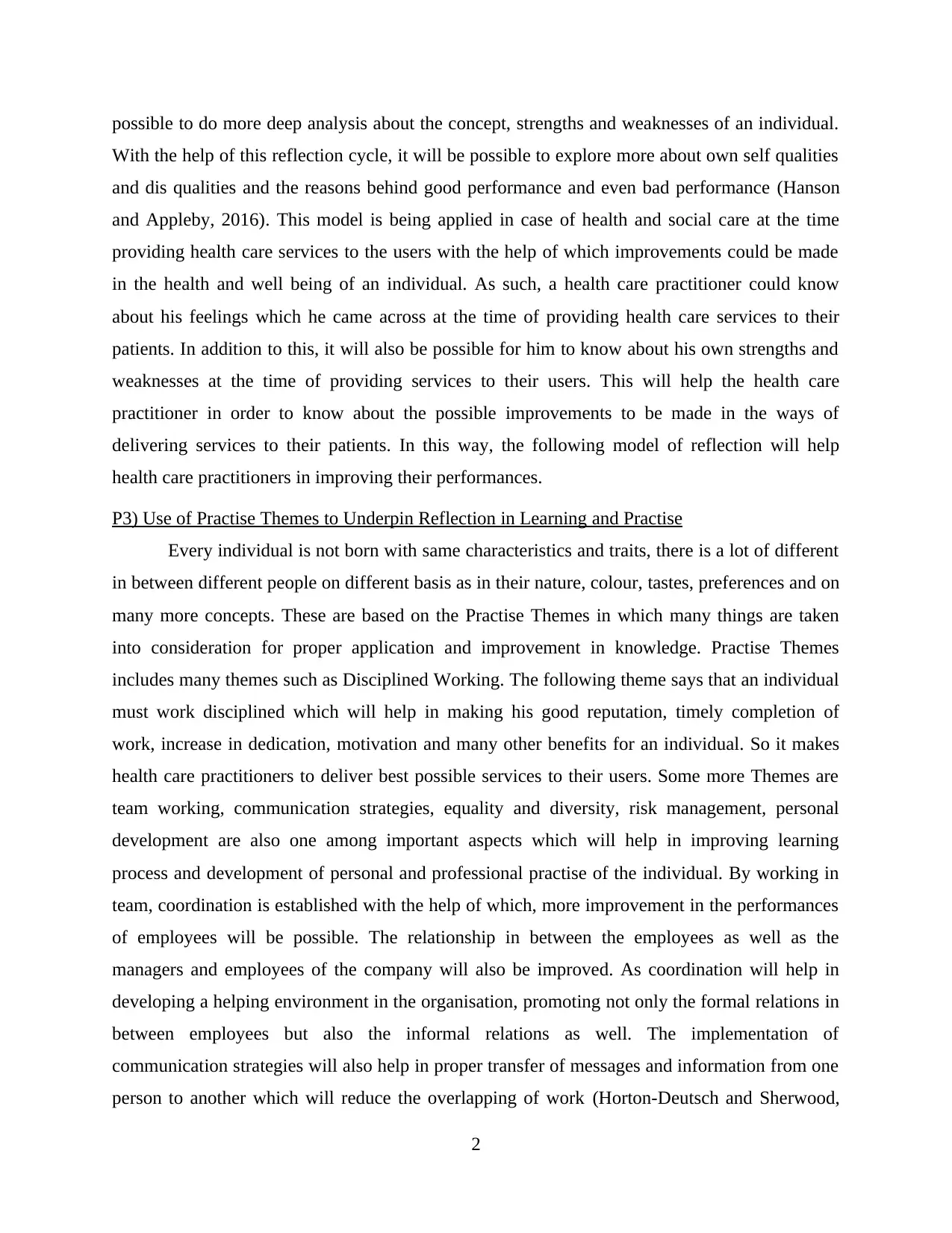
possible to do more deep analysis about the concept, strengths and weaknesses of an individual.
With the help of this reflection cycle, it will be possible to explore more about own self qualities
and dis qualities and the reasons behind good performance and even bad performance (Hanson
and Appleby, 2016). This model is being applied in case of health and social care at the time
providing health care services to the users with the help of which improvements could be made
in the health and well being of an individual. As such, a health care practitioner could know
about his feelings which he came across at the time of providing health care services to their
patients. In addition to this, it will also be possible for him to know about his own strengths and
weaknesses at the time of providing services to their users. This will help the health care
practitioner in order to know about the possible improvements to be made in the ways of
delivering services to their patients. In this way, the following model of reflection will help
health care practitioners in improving their performances.
P3) Use of Practise Themes to Underpin Reflection in Learning and Practise
Every individual is not born with same characteristics and traits, there is a lot of different
in between different people on different basis as in their nature, colour, tastes, preferences and on
many more concepts. These are based on the Practise Themes in which many things are taken
into consideration for proper application and improvement in knowledge. Practise Themes
includes many themes such as Disciplined Working. The following theme says that an individual
must work disciplined which will help in making his good reputation, timely completion of
work, increase in dedication, motivation and many other benefits for an individual. So it makes
health care practitioners to deliver best possible services to their users. Some more Themes are
team working, communication strategies, equality and diversity, risk management, personal
development are also one among important aspects which will help in improving learning
process and development of personal and professional practise of the individual. By working in
team, coordination is established with the help of which, more improvement in the performances
of employees will be possible. The relationship in between the employees as well as the
managers and employees of the company will also be improved. As coordination will help in
developing a helping environment in the organisation, promoting not only the formal relations in
between employees but also the informal relations as well. The implementation of
communication strategies will also help in proper transfer of messages and information from one
person to another which will reduce the overlapping of work (Horton-Deutsch and Sherwood,
2
With the help of this reflection cycle, it will be possible to explore more about own self qualities
and dis qualities and the reasons behind good performance and even bad performance (Hanson
and Appleby, 2016). This model is being applied in case of health and social care at the time
providing health care services to the users with the help of which improvements could be made
in the health and well being of an individual. As such, a health care practitioner could know
about his feelings which he came across at the time of providing health care services to their
patients. In addition to this, it will also be possible for him to know about his own strengths and
weaknesses at the time of providing services to their users. This will help the health care
practitioner in order to know about the possible improvements to be made in the ways of
delivering services to their patients. In this way, the following model of reflection will help
health care practitioners in improving their performances.
P3) Use of Practise Themes to Underpin Reflection in Learning and Practise
Every individual is not born with same characteristics and traits, there is a lot of different
in between different people on different basis as in their nature, colour, tastes, preferences and on
many more concepts. These are based on the Practise Themes in which many things are taken
into consideration for proper application and improvement in knowledge. Practise Themes
includes many themes such as Disciplined Working. The following theme says that an individual
must work disciplined which will help in making his good reputation, timely completion of
work, increase in dedication, motivation and many other benefits for an individual. So it makes
health care practitioners to deliver best possible services to their users. Some more Themes are
team working, communication strategies, equality and diversity, risk management, personal
development are also one among important aspects which will help in improving learning
process and development of personal and professional practise of the individual. By working in
team, coordination is established with the help of which, more improvement in the performances
of employees will be possible. The relationship in between the employees as well as the
managers and employees of the company will also be improved. As coordination will help in
developing a helping environment in the organisation, promoting not only the formal relations in
between employees but also the informal relations as well. The implementation of
communication strategies will also help in proper transfer of messages and information from one
person to another which will reduce the overlapping of work (Horton-Deutsch and Sherwood,
2
Paraphrase This Document
Need a fresh take? Get an instant paraphrase of this document with our AI Paraphraser
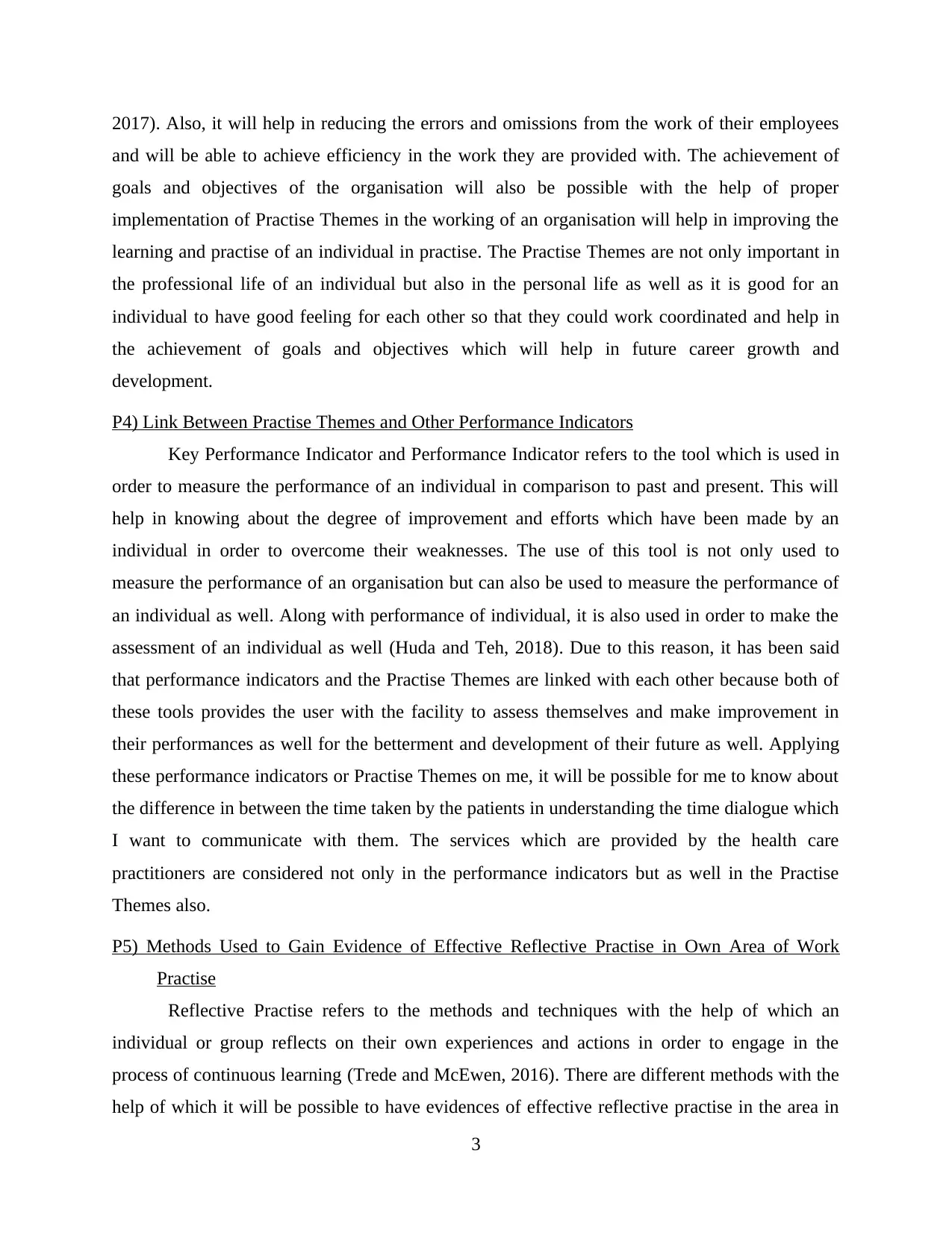
2017). Also, it will help in reducing the errors and omissions from the work of their employees
and will be able to achieve efficiency in the work they are provided with. The achievement of
goals and objectives of the organisation will also be possible with the help of proper
implementation of Practise Themes in the working of an organisation will help in improving the
learning and practise of an individual in practise. The Practise Themes are not only important in
the professional life of an individual but also in the personal life as well as it is good for an
individual to have good feeling for each other so that they could work coordinated and help in
the achievement of goals and objectives which will help in future career growth and
development.
P4) Link Between Practise Themes and Other Performance Indicators
Key Performance Indicator and Performance Indicator refers to the tool which is used in
order to measure the performance of an individual in comparison to past and present. This will
help in knowing about the degree of improvement and efforts which have been made by an
individual in order to overcome their weaknesses. The use of this tool is not only used to
measure the performance of an organisation but can also be used to measure the performance of
an individual as well. Along with performance of individual, it is also used in order to make the
assessment of an individual as well (Huda and Teh, 2018). Due to this reason, it has been said
that performance indicators and the Practise Themes are linked with each other because both of
these tools provides the user with the facility to assess themselves and make improvement in
their performances as well for the betterment and development of their future as well. Applying
these performance indicators or Practise Themes on me, it will be possible for me to know about
the difference in between the time taken by the patients in understanding the time dialogue which
I want to communicate with them. The services which are provided by the health care
practitioners are considered not only in the performance indicators but as well in the Practise
Themes also.
P5) Methods Used to Gain Evidence of Effective Reflective Practise in Own Area of Work
Practise
Reflective Practise refers to the methods and techniques with the help of which an
individual or group reflects on their own experiences and actions in order to engage in the
process of continuous learning (Trede and McEwen, 2016). There are different methods with the
help of which it will be possible to have evidences of effective reflective practise in the area in
3
and will be able to achieve efficiency in the work they are provided with. The achievement of
goals and objectives of the organisation will also be possible with the help of proper
implementation of Practise Themes in the working of an organisation will help in improving the
learning and practise of an individual in practise. The Practise Themes are not only important in
the professional life of an individual but also in the personal life as well as it is good for an
individual to have good feeling for each other so that they could work coordinated and help in
the achievement of goals and objectives which will help in future career growth and
development.
P4) Link Between Practise Themes and Other Performance Indicators
Key Performance Indicator and Performance Indicator refers to the tool which is used in
order to measure the performance of an individual in comparison to past and present. This will
help in knowing about the degree of improvement and efforts which have been made by an
individual in order to overcome their weaknesses. The use of this tool is not only used to
measure the performance of an organisation but can also be used to measure the performance of
an individual as well. Along with performance of individual, it is also used in order to make the
assessment of an individual as well (Huda and Teh, 2018). Due to this reason, it has been said
that performance indicators and the Practise Themes are linked with each other because both of
these tools provides the user with the facility to assess themselves and make improvement in
their performances as well for the betterment and development of their future as well. Applying
these performance indicators or Practise Themes on me, it will be possible for me to know about
the difference in between the time taken by the patients in understanding the time dialogue which
I want to communicate with them. The services which are provided by the health care
practitioners are considered not only in the performance indicators but as well in the Practise
Themes also.
P5) Methods Used to Gain Evidence of Effective Reflective Practise in Own Area of Work
Practise
Reflective Practise refers to the methods and techniques with the help of which an
individual or group reflects on their own experiences and actions in order to engage in the
process of continuous learning (Trede and McEwen, 2016). There are different methods with the
help of which it will be possible to have evidences of effective reflective practise in the area in
3
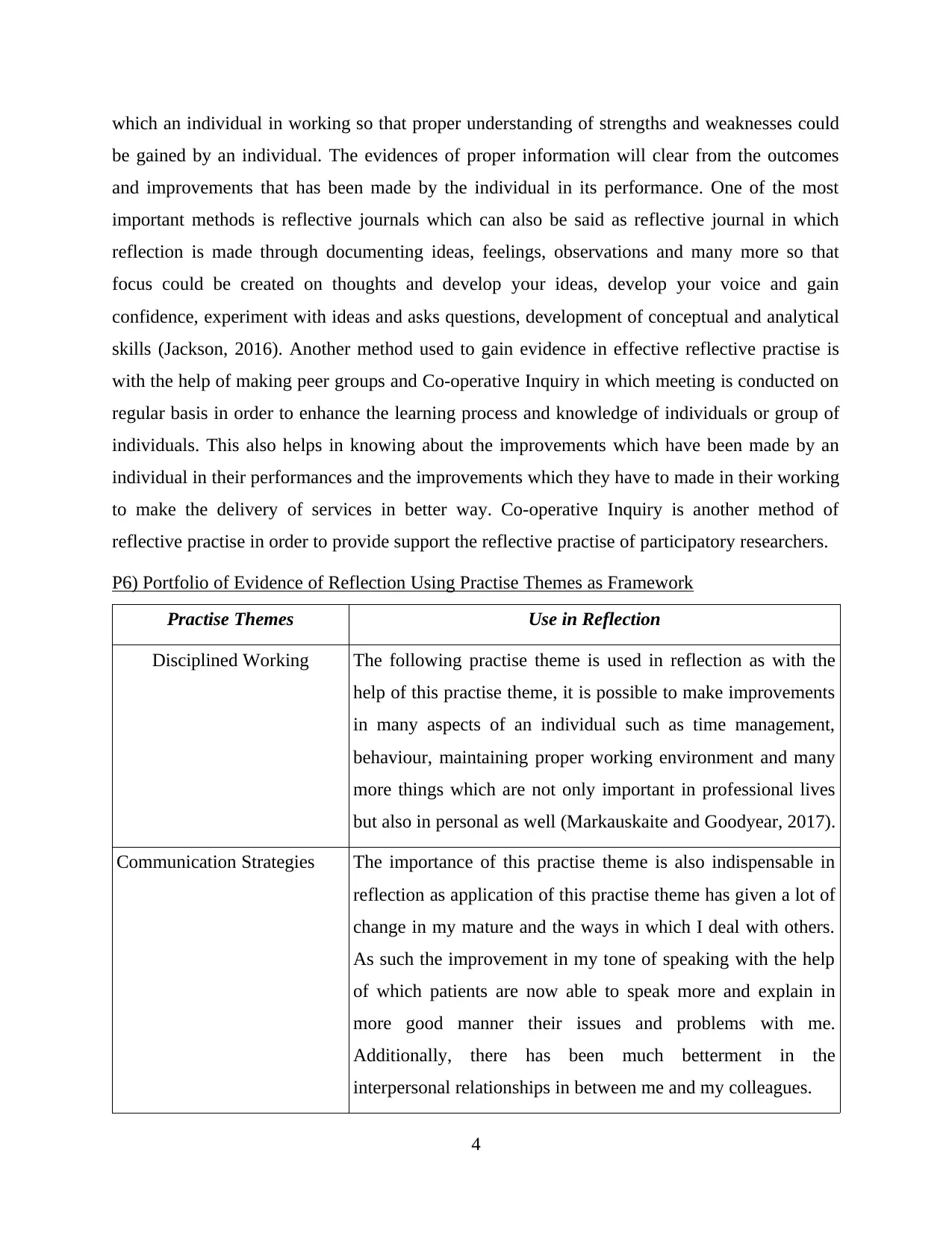
which an individual in working so that proper understanding of strengths and weaknesses could
be gained by an individual. The evidences of proper information will clear from the outcomes
and improvements that has been made by the individual in its performance. One of the most
important methods is reflective journals which can also be said as reflective journal in which
reflection is made through documenting ideas, feelings, observations and many more so that
focus could be created on thoughts and develop your ideas, develop your voice and gain
confidence, experiment with ideas and asks questions, development of conceptual and analytical
skills (Jackson, 2016). Another method used to gain evidence in effective reflective practise is
with the help of making peer groups and Co-operative Inquiry in which meeting is conducted on
regular basis in order to enhance the learning process and knowledge of individuals or group of
individuals. This also helps in knowing about the improvements which have been made by an
individual in their performances and the improvements which they have to made in their working
to make the delivery of services in better way. Co-operative Inquiry is another method of
reflective practise in order to provide support the reflective practise of participatory researchers.
P6) Portfolio of Evidence of Reflection Using Practise Themes as Framework
Practise Themes Use in Reflection
Disciplined Working The following practise theme is used in reflection as with the
help of this practise theme, it is possible to make improvements
in many aspects of an individual such as time management,
behaviour, maintaining proper working environment and many
more things which are not only important in professional lives
but also in personal as well (Markauskaite and Goodyear, 2017).
Communication Strategies The importance of this practise theme is also indispensable in
reflection as application of this practise theme has given a lot of
change in my mature and the ways in which I deal with others.
As such the improvement in my tone of speaking with the help
of which patients are now able to speak more and explain in
more good manner their issues and problems with me.
Additionally, there has been much betterment in the
interpersonal relationships in between me and my colleagues.
4
be gained by an individual. The evidences of proper information will clear from the outcomes
and improvements that has been made by the individual in its performance. One of the most
important methods is reflective journals which can also be said as reflective journal in which
reflection is made through documenting ideas, feelings, observations and many more so that
focus could be created on thoughts and develop your ideas, develop your voice and gain
confidence, experiment with ideas and asks questions, development of conceptual and analytical
skills (Jackson, 2016). Another method used to gain evidence in effective reflective practise is
with the help of making peer groups and Co-operative Inquiry in which meeting is conducted on
regular basis in order to enhance the learning process and knowledge of individuals or group of
individuals. This also helps in knowing about the improvements which have been made by an
individual in their performances and the improvements which they have to made in their working
to make the delivery of services in better way. Co-operative Inquiry is another method of
reflective practise in order to provide support the reflective practise of participatory researchers.
P6) Portfolio of Evidence of Reflection Using Practise Themes as Framework
Practise Themes Use in Reflection
Disciplined Working The following practise theme is used in reflection as with the
help of this practise theme, it is possible to make improvements
in many aspects of an individual such as time management,
behaviour, maintaining proper working environment and many
more things which are not only important in professional lives
but also in personal as well (Markauskaite and Goodyear, 2017).
Communication Strategies The importance of this practise theme is also indispensable in
reflection as application of this practise theme has given a lot of
change in my mature and the ways in which I deal with others.
As such the improvement in my tone of speaking with the help
of which patients are now able to speak more and explain in
more good manner their issues and problems with me.
Additionally, there has been much betterment in the
interpersonal relationships in between me and my colleagues.
4
⊘ This is a preview!⊘
Do you want full access?
Subscribe today to unlock all pages.

Trusted by 1+ million students worldwide
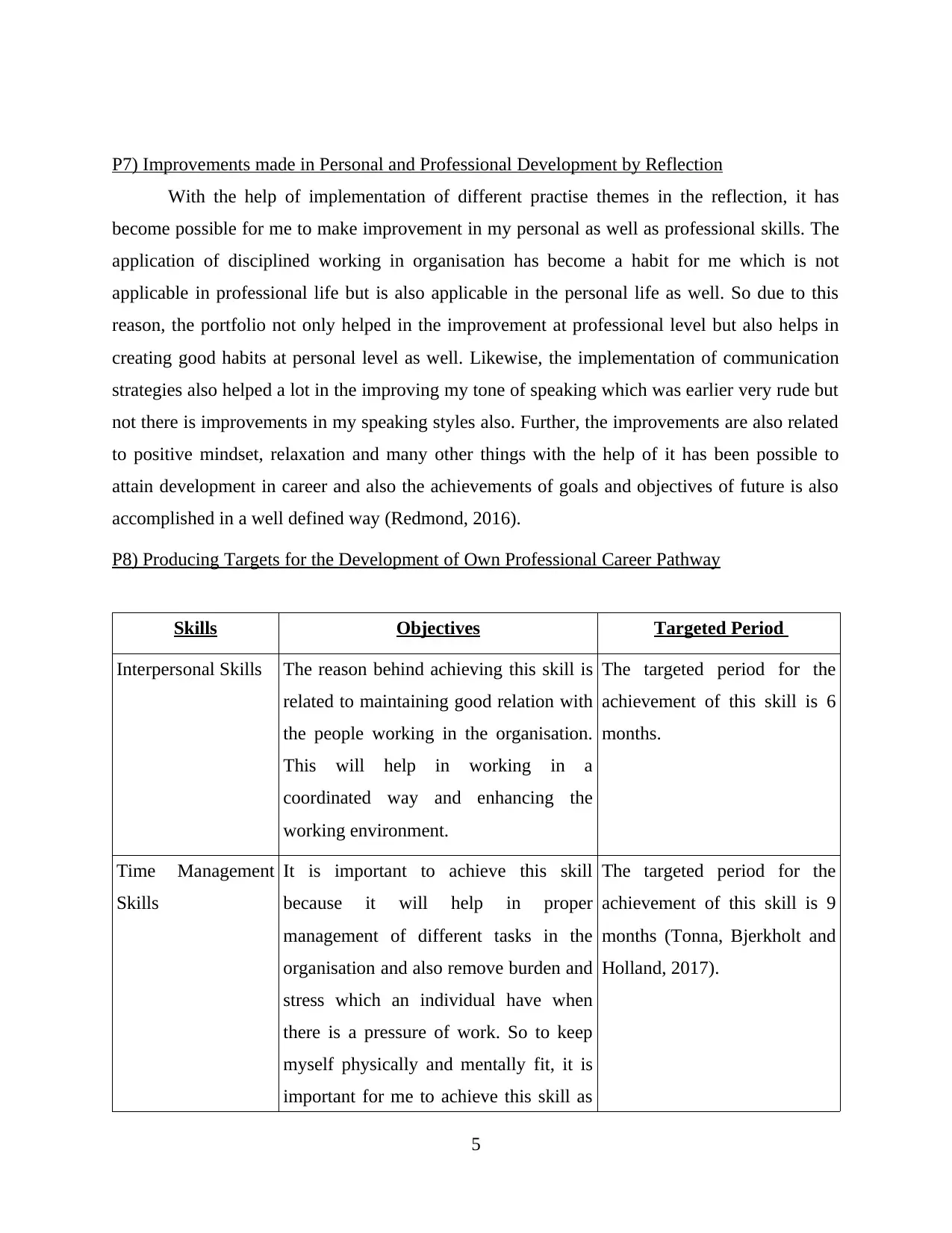
P7) Improvements made in Personal and Professional Development by Reflection
With the help of implementation of different practise themes in the reflection, it has
become possible for me to make improvement in my personal as well as professional skills. The
application of disciplined working in organisation has become a habit for me which is not
applicable in professional life but is also applicable in the personal life as well. So due to this
reason, the portfolio not only helped in the improvement at professional level but also helps in
creating good habits at personal level as well. Likewise, the implementation of communication
strategies also helped a lot in the improving my tone of speaking which was earlier very rude but
not there is improvements in my speaking styles also. Further, the improvements are also related
to positive mindset, relaxation and many other things with the help of it has been possible to
attain development in career and also the achievements of goals and objectives of future is also
accomplished in a well defined way (Redmond, 2016).
P8) Producing Targets for the Development of Own Professional Career Pathway
Skills Objectives Targeted Period
Interpersonal Skills The reason behind achieving this skill is
related to maintaining good relation with
the people working in the organisation.
This will help in working in a
coordinated way and enhancing the
working environment.
The targeted period for the
achievement of this skill is 6
months.
Time Management
Skills
It is important to achieve this skill
because it will help in proper
management of different tasks in the
organisation and also remove burden and
stress which an individual have when
there is a pressure of work. So to keep
myself physically and mentally fit, it is
important for me to achieve this skill as
The targeted period for the
achievement of this skill is 9
months (Tonna, Bjerkholt and
Holland, 2017).
5
With the help of implementation of different practise themes in the reflection, it has
become possible for me to make improvement in my personal as well as professional skills. The
application of disciplined working in organisation has become a habit for me which is not
applicable in professional life but is also applicable in the personal life as well. So due to this
reason, the portfolio not only helped in the improvement at professional level but also helps in
creating good habits at personal level as well. Likewise, the implementation of communication
strategies also helped a lot in the improving my tone of speaking which was earlier very rude but
not there is improvements in my speaking styles also. Further, the improvements are also related
to positive mindset, relaxation and many other things with the help of it has been possible to
attain development in career and also the achievements of goals and objectives of future is also
accomplished in a well defined way (Redmond, 2016).
P8) Producing Targets for the Development of Own Professional Career Pathway
Skills Objectives Targeted Period
Interpersonal Skills The reason behind achieving this skill is
related to maintaining good relation with
the people working in the organisation.
This will help in working in a
coordinated way and enhancing the
working environment.
The targeted period for the
achievement of this skill is 6
months.
Time Management
Skills
It is important to achieve this skill
because it will help in proper
management of different tasks in the
organisation and also remove burden and
stress which an individual have when
there is a pressure of work. So to keep
myself physically and mentally fit, it is
important for me to achieve this skill as
The targeted period for the
achievement of this skill is 9
months (Tonna, Bjerkholt and
Holland, 2017).
5
Paraphrase This Document
Need a fresh take? Get an instant paraphrase of this document with our AI Paraphraser
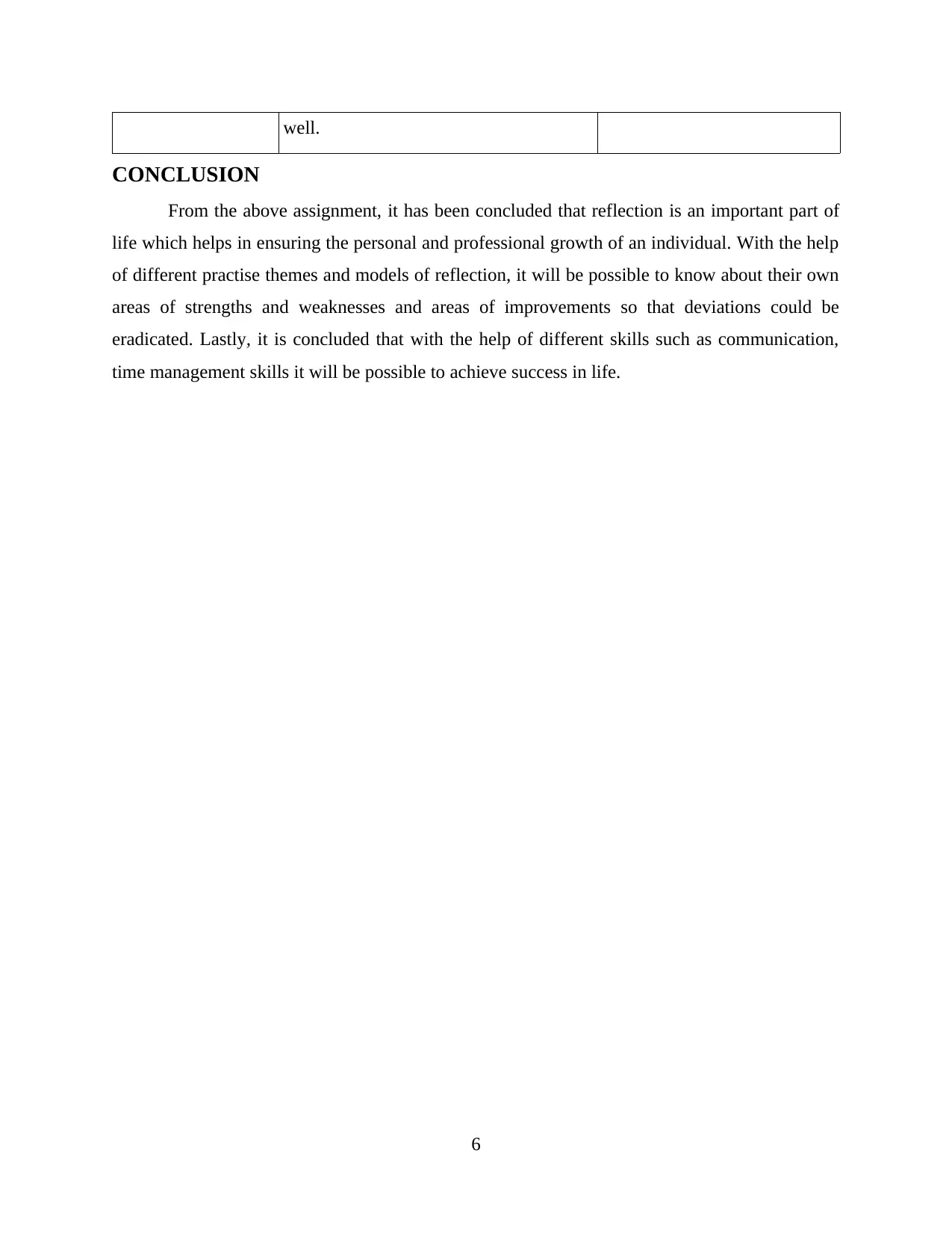
well.
CONCLUSION
From the above assignment, it has been concluded that reflection is an important part of
life which helps in ensuring the personal and professional growth of an individual. With the help
of different practise themes and models of reflection, it will be possible to know about their own
areas of strengths and weaknesses and areas of improvements so that deviations could be
eradicated. Lastly, it is concluded that with the help of different skills such as communication,
time management skills it will be possible to achieve success in life.
6
CONCLUSION
From the above assignment, it has been concluded that reflection is an important part of
life which helps in ensuring the personal and professional growth of an individual. With the help
of different practise themes and models of reflection, it will be possible to know about their own
areas of strengths and weaknesses and areas of improvements so that deviations could be
eradicated. Lastly, it is concluded that with the help of different skills such as communication,
time management skills it will be possible to achieve success in life.
6
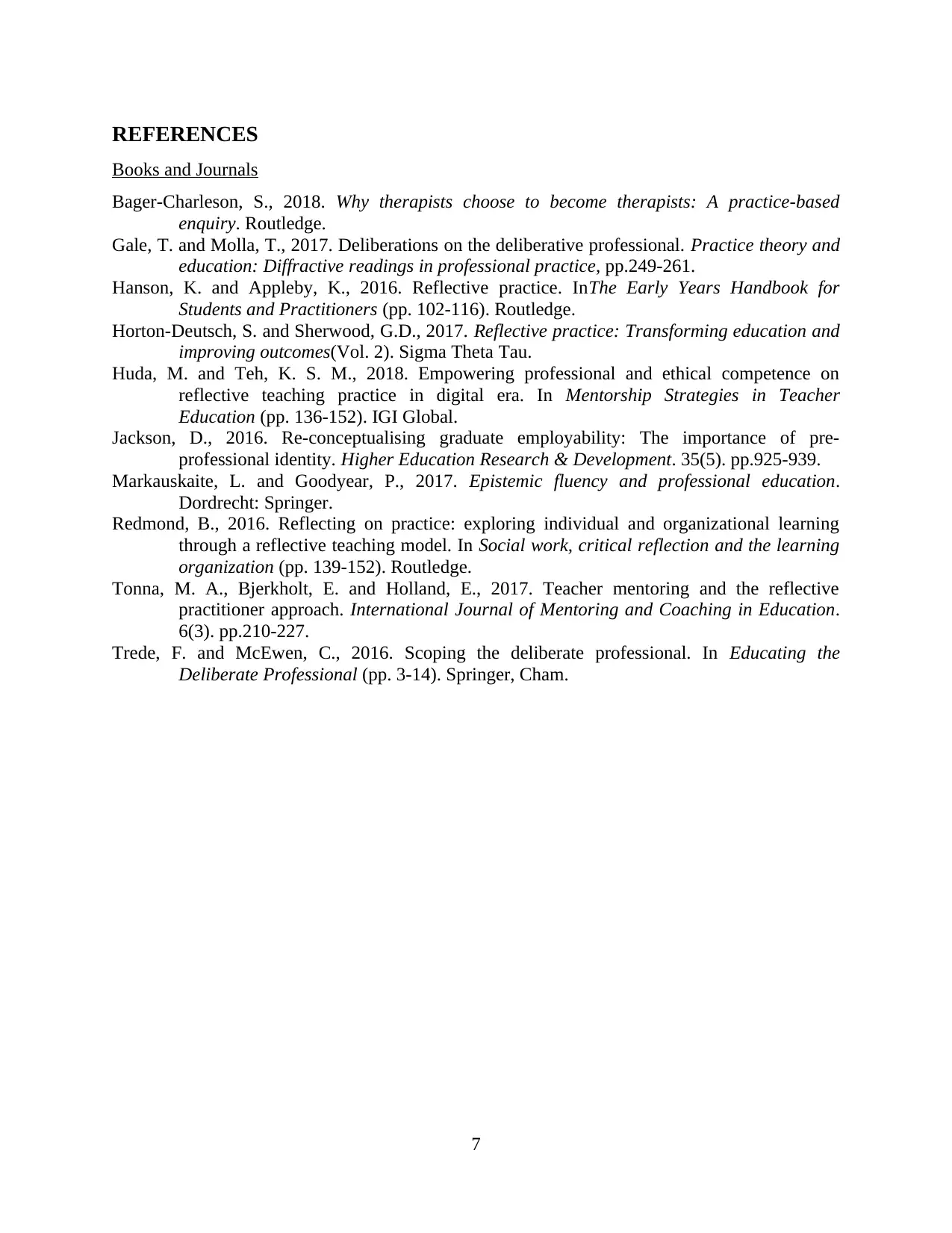
REFERENCES
Books and Journals
Bager-Charleson, S., 2018. Why therapists choose to become therapists: A practice-based
enquiry. Routledge.
Gale, T. and Molla, T., 2017. Deliberations on the deliberative professional. Practice theory and
education: Diffractive readings in professional practice, pp.249-261.
Hanson, K. and Appleby, K., 2016. Reflective practice. InThe Early Years Handbook for
Students and Practitioners (pp. 102-116). Routledge.
Horton-Deutsch, S. and Sherwood, G.D., 2017. Reflective practice: Transforming education and
improving outcomes(Vol. 2). Sigma Theta Tau.
Huda, M. and Teh, K. S. M., 2018. Empowering professional and ethical competence on
reflective teaching practice in digital era. In Mentorship Strategies in Teacher
Education (pp. 136-152). IGI Global.
Jackson, D., 2016. Re-conceptualising graduate employability: The importance of pre-
professional identity. Higher Education Research & Development. 35(5). pp.925-939.
Markauskaite, L. and Goodyear, P., 2017. Epistemic fluency and professional education.
Dordrecht: Springer.
Redmond, B., 2016. Reflecting on practice: exploring individual and organizational learning
through a reflective teaching model. In Social work, critical reflection and the learning
organization (pp. 139-152). Routledge.
Tonna, M. A., Bjerkholt, E. and Holland, E., 2017. Teacher mentoring and the reflective
practitioner approach. International Journal of Mentoring and Coaching in Education.
6(3). pp.210-227.
Trede, F. and McEwen, C., 2016. Scoping the deliberate professional. In Educating the
Deliberate Professional (pp. 3-14). Springer, Cham.
7
Books and Journals
Bager-Charleson, S., 2018. Why therapists choose to become therapists: A practice-based
enquiry. Routledge.
Gale, T. and Molla, T., 2017. Deliberations on the deliberative professional. Practice theory and
education: Diffractive readings in professional practice, pp.249-261.
Hanson, K. and Appleby, K., 2016. Reflective practice. InThe Early Years Handbook for
Students and Practitioners (pp. 102-116). Routledge.
Horton-Deutsch, S. and Sherwood, G.D., 2017. Reflective practice: Transforming education and
improving outcomes(Vol. 2). Sigma Theta Tau.
Huda, M. and Teh, K. S. M., 2018. Empowering professional and ethical competence on
reflective teaching practice in digital era. In Mentorship Strategies in Teacher
Education (pp. 136-152). IGI Global.
Jackson, D., 2016. Re-conceptualising graduate employability: The importance of pre-
professional identity. Higher Education Research & Development. 35(5). pp.925-939.
Markauskaite, L. and Goodyear, P., 2017. Epistemic fluency and professional education.
Dordrecht: Springer.
Redmond, B., 2016. Reflecting on practice: exploring individual and organizational learning
through a reflective teaching model. In Social work, critical reflection and the learning
organization (pp. 139-152). Routledge.
Tonna, M. A., Bjerkholt, E. and Holland, E., 2017. Teacher mentoring and the reflective
practitioner approach. International Journal of Mentoring and Coaching in Education.
6(3). pp.210-227.
Trede, F. and McEwen, C., 2016. Scoping the deliberate professional. In Educating the
Deliberate Professional (pp. 3-14). Springer, Cham.
7
⊘ This is a preview!⊘
Do you want full access?
Subscribe today to unlock all pages.

Trusted by 1+ million students worldwide
1 out of 9
Related Documents
Your All-in-One AI-Powered Toolkit for Academic Success.
+13062052269
info@desklib.com
Available 24*7 on WhatsApp / Email
![[object Object]](/_next/static/media/star-bottom.7253800d.svg)
Unlock your academic potential
Copyright © 2020–2025 A2Z Services. All Rights Reserved. Developed and managed by ZUCOL.




